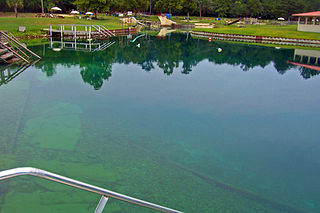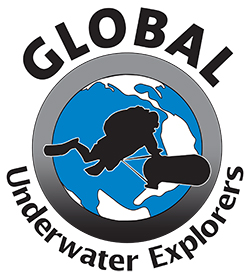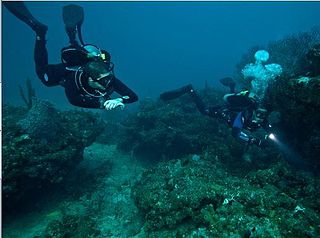Related Research Articles

Technical diving is scuba diving that exceeds the agency-specified limits of recreational diving for non-professional purposes. Technical diving may expose the diver to hazards beyond those normally associated with recreational diving, and to a greater risk of serious injury or death. The risk may be reduced by appropriate skills, knowledge and experience, and by using suitable equipment and procedures. The skills may be developed through appropriate specialised training and experience. The equipment often involves breathing gases other than air or standard nitrox mixtures, and multiple gas sources.

Cave-diving is underwater diving in water-filled caves. It may be done as an extreme sport, a way of exploring flooded caves for scientific investigation, or for the search for and recovery of divers lost as a result of one of these activities. The equipment used varies depending on the circumstances, and ranges from breath hold to surface supplied, but almost all cave-diving is done using scuba equipment, often in specialised configurations with redundancies such as sidemount or backmounted twinset. Recreational cave-diving is generally considered to be a type of technical diving due to the lack of a free surface during large parts of the dive, and often involves planned decompression stops. A distinction is made by recreational diver training agencies between cave-diving and cavern-diving, where cavern diving is deemed to be diving in those parts of a cave where the exit to open water can be seen by natural light. An arbitrary distance limit to the open water surface may also be specified.
Sheck Exley was an American cave diver. He is widely regarded as one of the pioneers of cave diving, and he wrote two major books on the subject: Basic Cave Diving: A Blueprint for Survival and Caverns Measureless to Man. On February 6, 1974, Exley became the first chairman of the Cave Diving Section of the American National Speleological Society. During his career, he established many of the basic safety procedures used in cave and overhead diving today. Exley was also a pioneer of extreme deep scuba diving.

Scuba diving is a mode of underwater diving whereby divers use breathing equipment that is completely independent of a surface air supply. The name "scuba", an acronym for "Self-Contained Underwater Breathing Apparatus", was coined by Christian J. Lambertsen in a patent submitted in 1952. Scuba divers carry their own source of breathing gas, usually compressed air, affording them greater independence and movement than surface-supplied divers, and more time underwater than free divers. Although the use of compressed air is common, a gas blend with a higher oxygen content, known as enriched air or nitrox, has become popular due to the reduced nitrogen intake during long and/or repetitive dives. Also, breathing gas diluted with helium may be used to reduce the likelihood and effects of nitrogen narcosis during deeper dives.
Forest Hill Community High School (FHCHS) also known as Forest Hill or The Hill, is a coeducational public high school in West Palm Beach, Florida with an enrollment of 2,457 students. The school is a part of the School District of Palm Beach County.
The Woodville Karst Plain is a 450-square-mile (1,200 km2) karst area that runs from Tallahassee, Florida, U.S. to the Gulf of Mexico separated by the Cody Scarp.
The Woodville Karst Plain Project or WKPP, is a project and organization that maps the underwater cave systems underlying the Woodville Karst Plain. This plain is a 450-square-mile (1,200 km2) area that runs from Tallahassee, Florida, U.S. to the Gulf of Mexico and includes numerous first magnitude springs, including Wakulla Springs, and the Leon Sinks Cave System, the longest underwater cave in the United States. The project grew out of a cave diving research and exploration group established in 1985 and incorporated in 1990.

Wes Skiles Peacock Springs State Park is a 733-acre (297 ha) Florida State Park located on Peacock Springs Road, two miles (3 km) east of Luraville and on State Road 51, 16 miles (26 km) southwest of Live Oak, Florida. Activities include picnicking, swimming and diving, and wildlife viewing. Among the wildlife of the park are deer, bobcats, raccoon, squirrels, beaver and otters, as well as turkey, blue heron and barred owls. The park name commemorates the work of diver and explorer Wes Skiles. Prior to 2010 the park was known as Peacock Springs State Park. Amenities include a nature trail, six sinkholes, and Peacock and Bonnet Springs, with miles of underwater caves popular with cave divers. The two springs are tributaries of the Suwannee River. The park is open from 8:00 am till sundown year round.

Wakulla Springs is located 14 miles (23 km) south of Tallahassee, Florida and 5 miles (8.0 km) east of Crawfordville in Wakulla County, Florida at the crossroads of State Road 61 and State Road 267. It is protected in the Edward Ball Wakulla Springs State Park.

The Leon Sinks Geological Area is located on the Woodville Karst Plain in southern and southwestern Leon County, Florida, United States. It is a mature karstic area on the Upper Floridan Aquifer. It is one of the most extensive underwater cave systems in the world and connects to Wakulla Springs.
William C. "Bill" Stone is an American engineer, caver and explorer, known for exploring deep caves, sometimes with autonomous underwater vehicles. He has participated in over 40 international expeditions and is president and CEO of Stone Aerospace.

Vortex Spring is a commercially operated recreation, camping and dive park located near Ponce de Leon, Florida. It is the largest diving facility in the state of Florida.

Karst Underwater Research (KUR) is a registered 501(c)(3) non-profit organization that specializes in the research and documentation of karst aquifers and their corresponding surface features. KUR members perform a variety of scientific processes, including mapping and cartography, radio location, photography, videography, YSI water analysis and sampling.

Global Underwater Explorers (GUE) is a scuba diving organization that provides education within recreational, technical, and cave diving. It is a nonprofit membership organization based in High Springs, Florida, United States.

Tom Mount was an American pioneering cave diver and technical diver.

William "Bill" Hogarth Main is a cave diving pioneer who is best known as a developer in the 1980s, and the namesake of, the "Hogarthian gear configuration" that is a component of the "Doing It Right" (DIR) holistic approach to scuba diving. According to Jarrod Jablonski, the Hogarthian style "has many minor variations, yet its focus asserts a policy of minimalism." The configuration was refined in the 1990s, partially through the Woodville Karst Plain Project (WKPP), established in 1985 and considered among the most aggressive cave diving initiatives in the world.

Doing It Right (DIR) is a holistic approach to scuba diving that encompasses several essential elements, including fundamental diving skills, teamwork, physical fitness, and streamlined and minimalistic equipment configurations. DIR proponents maintain that through these elements, safety is improved by standardizing equipment configuration and dive-team procedures for preventing and dealing with emergencies.

Cave diving is underwater diving in water-filled caves. The equipment used varies depending on the circumstances, and ranges from breath hold to surface supplied, but almost all cave diving is done using scuba equipment, often in specialised configurations with redundancies such as sidemount or backmounted twinset. Recreational cave diving is generally considered to be a type of technical diving due to the lack of a free surface during large parts of the dive, and often involves planned decompression stops. A distinction is made by recreational diver training agencies between cave diving and cavern diving, where cavern diving is deemed to be diving in those parts of a cave where the exit to open water can be seen by natural light. An arbitrary distance limit to the open water surface may also be specified. Despite the risks, water-filled caves attract scuba divers, cavers, and speleologists due to their often unexplored nature, and present divers with a technical diving challenge.
References
- 1 2 3 4 5 "EuroTek - Jarrod Jablonski". EuroTek. Archived from the original on 2009-09-06. Retrieved 2010-05-13.
- ↑ Jablonski, J (2001). Doing it Right: The Fundamentals of Better Diving. Global Underwater Explorers. ISBN 0-9713267-0-3.
- ↑ Hobbs, Gene (2013). "Rescue of an Unconscious Diver". Alert Diver. Divers Alert Network . Retrieved 2013-12-17.
- ↑ Global Underwater Explorers. "GUE Course Descriptions". Archived from the original on 2008-10-12. Retrieved 2010-05-13.
- ↑ Global Underwater Explorers. "GUE Membership". Archived from the original on 2008-09-09. Retrieved 2010-05-13.
- ↑ Global Underwater Explorers. "Contact GUE". Archived from the original on 2009-08-22. Retrieved 2010-05-13.
- ↑ Gillman, G. "Staying alive while looking good: Local stores lead the way in setting scuba trends". High Springs Herald. Archived from the original on 2004-08-03. Retrieved 2010-05-13.
- ↑ "Record penetration was completed at Manatee Springs". cavedivinghistory.com. Retrieved 2010-05-12.
- ↑ McKinlay, Casey; Wisenbaker, Mike. "Exploration chronology". Global Underwater Explorers. Archived from the original on 2011-06-11. Retrieved 2010-05-13.
- ↑ Tallahassee Democrat (2006-06-18). "Wakulla Springs through the ages" . Retrieved 2010-05-13.
- ↑ McKinlay, Casey (2008). "WKPP – Wakulla Springs – June 12–14, 2008 "The Return to Q"". Global Underwater Explorers. Archived from the original on 2011-06-11. Retrieved 2010-05-13.
- ↑ Gainesville Sun. November 15th, 2016.
- ↑ Pulver, Dinah Voyles (August 1, 2007). "Underwater cave systems proves longest in N. America". News-Journal Corporation. Retrieved 2010-05-13.
- 1 2 Kernagis Dawn N; McKinlay Casey; Kincaid Todd R (2008). "Dive Logistics of the Turner to Wakulla Cave Traverse". In: Brueggeman P, Pollock NW, Eds. Diving for Science 2008. Proceedings of the American Academy of Underwater Sciences 27th Symposium. Dauphin Island, AL: AAUS. Archived from the original on December 28, 2012. Retrieved 2010-05-13.
{{cite journal}}: CS1 maint: unfit URL (link) - ↑ Valencia, Jorge (April 19, 2013). "Swimming The Sinkholes". NPR: The Story. Retrieved 2013-02-27.
- ↑ Handwerk, Brian (December 17, 2007). "Divers Break Record for Longest Cave Passage". National Geographic News. Retrieved 2010-05-13.
- 1 2 Florida House of Representatives. "House Resolution 9053" . Retrieved 2011-04-06.
{{cite journal}}: Cite journal requires|journal=(help) - ↑ "Events - Jarrod Jablonski and Casey McKinlay : Exploring The World's Longest Underwater Cave System". The Explorers Club. Retrieved 26 April 2018.
- ↑ Lunn, Rosemary E (26 April 2018). "Jarrod Jablonski is DAN Rolex 2018 Diver of the Year". X-Ray Mag. Retrieved 26 April 2018.